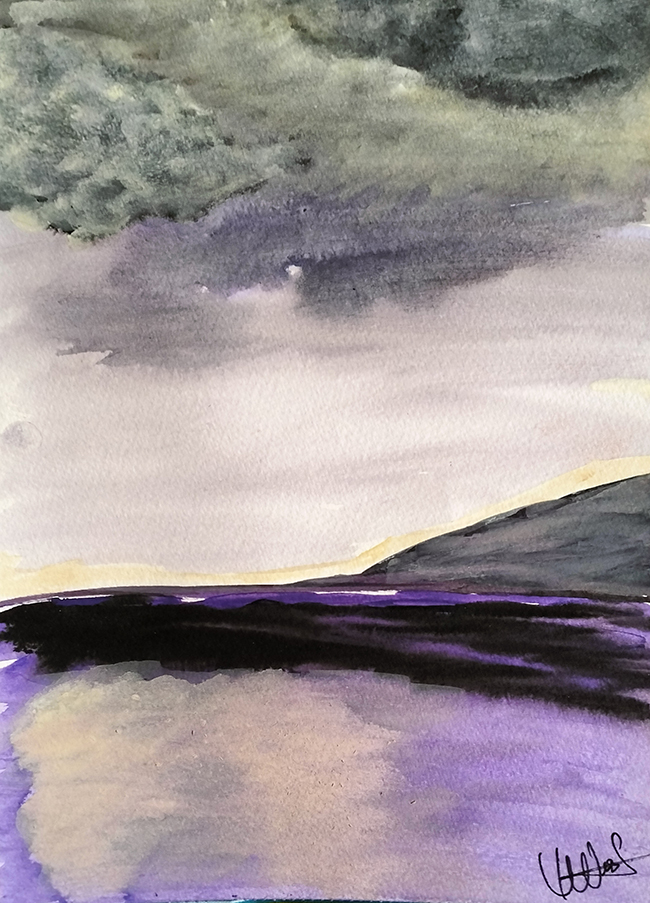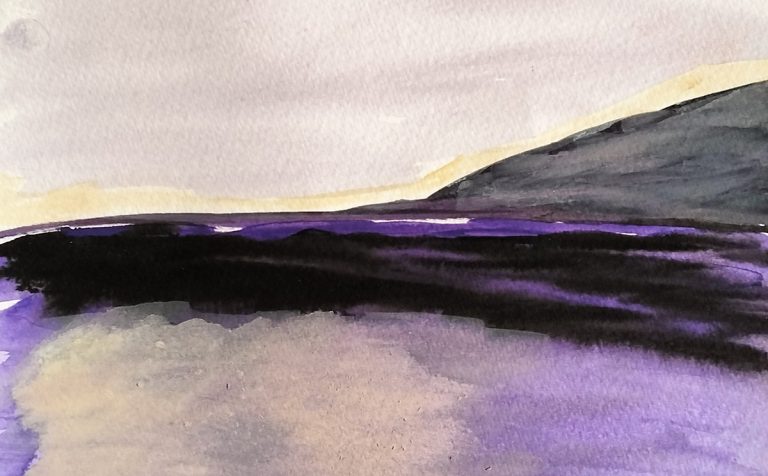Mandy West didn’t come into art with a formal education or years of gallery-hopping behind her. She started painting seriously in 2022, and that fresh, unpolished approach is part of what gives her work its pulse. She calls herself a mixed media artist, but that doesn’t fully capture what she does. Mandy is more of a creative wanderer—testing materials, combining techniques, and leaning into whatever draws her in that day. One moment she’s working with wax, the next she’s layering plaster into peaks, or scratching lines into wood grain. She’s not trying to perfect an image. She’s trying to stir something. Her work isn’t tidy, but it’s honest. What matters most to her is making a connection—between materials, between ideas, and between herself and whoever’s looking.

Looking at Mandy West’s painting is like pausing mid-thought in a wide open place. The work she made here is deceptively simple—a dark shoreline, a sky thick with mood, and a wash of violet that sits like twilight on water. It’s painted in watercolor, but the handling of pigment isn’t delicate. It’s direct. You can see where the brush wanted to move fast, where the water dragged the color too far, where the darkness pools just a little too heavily. But that’s what makes it feel human. Nothing is precious. Everything feels intentional without being overworked.
The sky alone tells a whole story. Heavy greenish clouds crowd the upper third, pressing down, ready to break open. Below them, a muted lavender-grey haze washes across the horizon. It’s not quite stormy, not quite peaceful—just that quiet, loaded in-between space. It reads like a mood more than a setting. You can’t tell exactly where you are, and you don’t need to. It could be a memory. It could be a dream. It doesn’t have to resolve into a postcard.
That kind of ambiguity is something Mandy leans into. She’s not interested in rendering a landscape exactly as it is. She’d rather you feel the scene. In this painting, she lets color do the heavy lifting. A deep black-violet cuts across the bottom like a low tide or a shadow cast by a hill. The water, if it is water, reflects that same violet, mixed with dusty ochre and the faintest trace of blue. There’s motion here, but it’s slowed down, as if the whole place is waiting for something. It’s introspective without being sentimental.
The paper itself becomes part of the story. The grain shows through the thin washes, especially in the sky and the water. You can see the texture fighting the pigment, absorbing it unevenly. That rawness adds to the atmosphere—it reminds you this is hand-made, not printed, not filtered. Mandy doesn’t hide the flaws. She invites them in.
What’s striking is how she can get so much from so little. There’s no detailed foliage, no distant buildings, no figures walking along the shore. Yet the painting feels complete. It holds a space. And that’s something that runs through all of her work—this ability to evoke something familiar using abstraction and minimal cues. She doesn’t try to impress with complexity. She lets the materials speak plainly.
Mandy’s process is exploratory. She’s known to switch surfaces, from paper to wood, or use wax and plaster when paint alone doesn’t cut it. She draws as much with tools as with her hands. That tactile engagement carries over even when the result is a quiet landscape like this. There’s a push and pull in her work—a balance between control and chance, presence and absence.
For someone who only started showing her work recently, Mandy paints like someone who trusts her own instincts. That’s rare. She doesn’t crowd the canvas. She doesn’t over-explain. Her painting says just enough, and then steps back. It lets you fill in the rest. And in doing that, it becomes less about her, and more about you.
This is art that doesn’t beg for attention. It holds still. It waits. And if you stay with it long enough, it opens something up. That’s what Mandy West is after—not perfection, but connection. And in this work, she’s found it.

